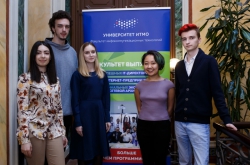About Eduroam
Eduroam (education roaming) originated in 2002 thanks to the TERENA non-profit organization from the Netherlands. TERENA’s mission is to contribute to the development of technological infrastructure that is imperative for collaboration in the field of education in Europe and around the world. Thus, they introduce new communication systems, conduct lectures and workshops on knowledge and technology transfer, act as an advisor to governments on the issues of creating communication channels and interaction in the field of science and education. TERENA is the owner of several services, including the Eduroam brand.
Eduroam’s operating principle is simple. In each country that introduces this technology, there are servers that store Eduroam data. For instance, if a person registered in the system is from Belgium, and later comes to ITMO University and logs in from there, Eduroam’s servers in Russia connect with the server in Belgium. That server returns information on whether the user is registered in the system, and this data is then sent to the university.
The service is meant for use in universities, scientific institutions, and research centers. So, one can only register in Eduroam by sending a request to the IT-department of a university that part of the system. If one tries to register from an off-site computer, from home, for instance, the request will be denied. Still, in some countries, they use Eduroam not only in scientific and educational establishments, but in libraries, municipal buildings, and transport hubs as well. In Belgium and the Netherlands, Eduroam is even used by the state administration.
 Credit: Eduroam.org
Credit: Eduroam.org
Eduroam at ITMO University
In the first non-classical, Eduroam is now available in the buildings on Birzhevaya line 14/16, Lomonosova str. 9, Chaikovskogo str. 11 and Kadetskaya line 3. As of now, the service is provided to international students only; one should also keep in mind that the service can't be used at the university they are registered in – otherwise it would become just a counterpart of the free Wi-Fi network. Yet, you can use it if you go to a different university.
“Every day, no less than 10 people connect to Eduroam from our university. There are a lot more users during international conferences - we often host such events at the Department of Nanophotonics and Metamaterials, or during international summer schools. Authorization requests come from users registered in different countries throughout the world: Norway, Sweden, Italy, Germany, Great Britain, Canada, China, Brazil, Australia, Japan, Estonia and many others. All in all, about 500 people have used this network since March. The system’s main advantage is that the users don’t have to connect to unknown networks and register anew, especially when there can be additional requirements for registering as we often have it in our country. For ITMO University, being part of this network is another step into the international educational system. Any self-respecting organization working in the field of science and education should be connected to it,” comments Nikita Samokhin, engineer at the university’s Department of Infocommunication Management.
Eduroam in Russia is yet to develop to a sufficient level; as of now, it is available at the Higher School of Economics, St. Petersburg’s Polytechnical University, St. Petersburg State University, Ural Federal University, Tomsk Polytechnical University and some other places. As for the world, about 70 countries are part of it. The connections’ security is provided by the domestic resources of the organizations who use it.





